| |
|
|
| Bible Code Digest: January/February 2025 Continued |
|
|---|
Closeness Comparisons:
A Substantive Basis for Testing
the Claimed Reality of Bible Codes
Summary
In this article, we examine a collection of evidence of encoding in the Bible where the odds of chance occurrence are very remote (one in 373 million) and are based on a statistically significant sample of 50 independent observations. These observations are completely objective, being totally free of any subjectivity in the translation of Hebrew into English. In other words, this is hard, conclusive evidence that the phenomenon of Bible codes is real.
What kind of evidence is this? Suppose you searched for ELSs of David the King, where David is spelled DVYD (dalet, vav, yod, dalet). You noted the location of the 25 ELSs with the shortest skips in the Tanakh, and you recorded the shortest distance between any of the letters of each of these ELSs and literal appearances of the name David in the Tanakh. Table 1 presents the results, ranked by the shortest distance for each ELS.
Table 1
Minimum Distance Between the Letters of David (DVYD) the King ELSs
and Literal Appearances of David in the Tanakh
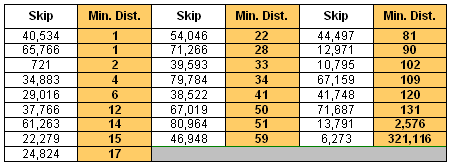
That some of these David (DVYD) the King ELSs would be close to literal appearances of David in the Tanakh is not surprising. What is unexpected is that all but two of the 25 are quite close. How unusual is this? We derived odds of one in 52,632 of the above minimum distances being as small as they are being due to chance. Most unusual, and there is more.
An alternative royal title for David is The King David (DVYD). For this additional title, we noted the location of the 25 ELSs with the shortest skips in the Tanakh. The set of minimum distances were almost as small as a group as those shown in Table 1. We derived odds of one in 7,092 of the minimum distances being as small as they are because of chance.
Together the odds of chance occurrence of the minimum distances we observed for these two royal titles were one in 373,266,144, or one in 373 million. We are looking at an exceptionally non-random phenomenon using 50 observations � not just a few pieces of isolated anecdotal evidence. From a statistical standpoint, that is a sample size large enough that a decisive inference can be made. This is clearly not a coincidence.
What is also intriguing about this evidence is that it is drawn from a collection of 50 ELSs, most of which have very large skips (for example, more than 10,000), that are scattered throughout the Tanakh. This is not just evidence of isolated encoding, but of general encoding over the entire Old Testament.
General Introduction
Location, location, location . . . sounds like a realtor's mantra. Yet it could also be that of a Bible code researcher. Most if not all technically strong code researchers would attest to the validity of the link between the subject matter of the literal text and the content of codes found there. Their convictions are based on a long series of observations of unique situations, or what scientists call "anecdotal evidence." These researchers have observed this pervasive phenomenon, and are convinced of it. The problem with anecdotal evidence is that there is rarely enough of it of the exact same kind that it would add up to statistically conclusive proof.
Simply presenting yet another collection of new and intriguing pieces of anecdotal evidence is no way to convince skeptical scientists of the potential validity of any Bible code phenomenon. What is needed is some way to focus on the location phenomenon in a way that involves enough objective observations that a highly improbable result could possibly occur. What is needed are 25, or 50, or 100, or more, observations of the same kind where a comparison can be made between actual and expected results. Just such a situation is described in this article, and the odds against chance occurrence are less than one in 27 million. Before we cover it, however, we will first look at a simple example that resembles the more complex one we are really interested in.
What sort of experiment would one conduct to test the general observation that there is a strong correlation between the subject matter of Bible codes and the literal content of the text where such codes appear? To be compelling, it would be most useful if the topic in the literal text were one that appeared a large number of times and if the subject matter of the ELSs were terms that were undisputable in their linkage to the original topic and in their spelling. If there were several terms, then selection of some obvious grouping of terms would also strengthen the credibility of the experiment.
Closeness of ELSs of The King David to Literal Appearances of David in the Tanakh
The name David appears exactly 1,061 times in the Tanakh. And the formal names of the kings of the House of David appear hundreds of times as ELSs in the Tanakh. What if we were to note the shortest distance (in letters) between each of the five ELSs of each king's proper title with the shortest skips and any literal appearance of David in the text? As a control, we would randomly scramble the letters of each king's proper title and then note the shortest distance between each of the five ELSs of ten scrambled royal titles.
In the Tanakh, David is spelled two different ways. It is dalet-vav-dalet in the earlier history books (i.e., 1 and 2 Samuel and 1 and 2 Kings), and it is dalet-vav-yod-dalet in the later history books (1 and 2 Chronicles).
Suppose we do this for the royal title, The King David (DVD). The following table displays the minimum distances of each of the five The King David (DVD) ELSs with the shortest skips in the Tanakh, followed by the corresponding minimum distances for twenty random scramblings of The King David (DVD).
Table 2
Minimum Distances Between the Letters of David (DVD) the King ELSs
(and ELSs of Scramblings of "David the King")
and Literal Appearances of David in the Tanakh
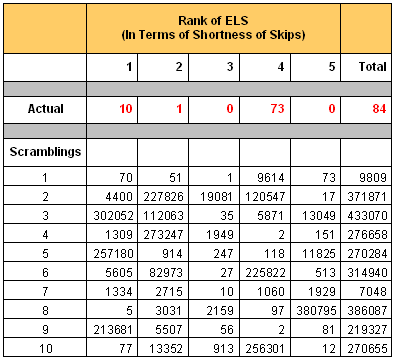
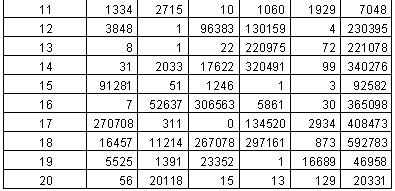
As we can see, the sum of the minimum distances for the actual title, The King David, is dramatically less than it is for each of the twenty scramblings. Can we derive the odds against the sum of the minimum distances of the five The King David ELSs from this? In reality, we have too few observations to do this.
What scramblings were used? The King David is spelled (reading left to right) HMLKDVD (heh-mem-lamed-kaf-dalet-vav-dalet). The first 10 scramblings for which results are shown in Table 1 are:
Table 3
Scramblings of "The King David"

These scramblings were obtained by assigning the numbers one through seven to the seven Hebrew letters of The King David. These numbers were then scrambled randomly and the corresponding Hebrew letters are shown above.
We also did the above for 10 scramblings of David the King, which has the same letters. This is how we obtained the sum of the minimum distances for 20 scramblings of The King David.
Comparison of Results with Those for Other Kings in the House of David
We could also do this for the royal titles of the different kings of the House of David for which at least 25 ELSs could be found. (A criteria of 25 ELSs was chosen because the situation we will focus on later involves a review of the 25 ELSs with the shortest skips for different royal names.) There are eight other kings, if we include King Saul. So there are nine royal titles for which we have 20 scramblings each. We, therefore, have 180 control results.
Suppose for now we just look at the actual minimum distances for the 18 real names of these kings, leaving out the scramblings of those names. These are shown below, where each is ranked from the smallest to the highest average of the five minimum distances.
Table 4
Minimum Distances Between the Letters of ELSs of Various
Royal Titles and Literal Appearances of David in the Tanakh
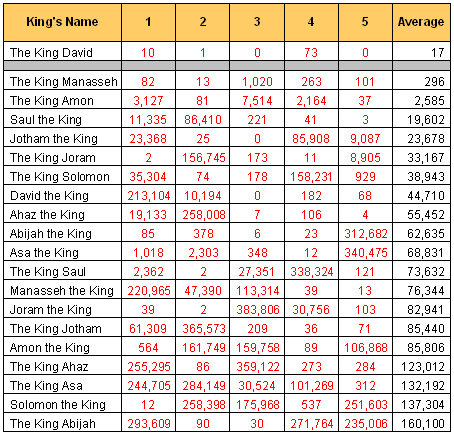
As is obvious from the above, none of the ELSs of the names of the other kings have an average of the minimum distances that is anywhere as small as that for The King David. Yet, we still do not have enough results to begin to reasonably estimate the probability that the five shortest skip The King David ELSs would a total minimum distance as short as is the case. Adding the 10 scramblings for each of the twenty other royal names does help in this regard, however. Here is what the above table looks like for the 20 scramblings (out of a total of 200) with the shortest total minimum distance.
Table 5
Minimum Distances Between the Letters of ELSs of Scramblings
of Various Royal Titles and Literal Appearances of David in the Tanakh
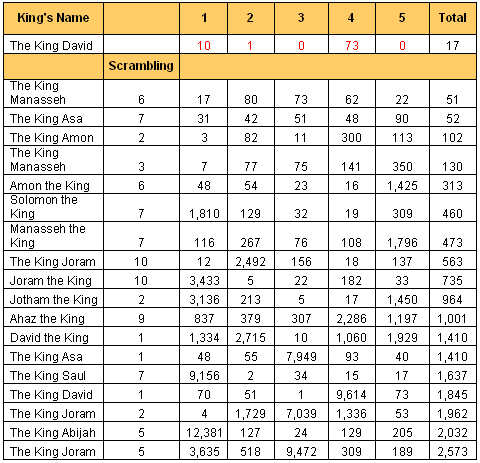
Since none of the 180 scramblings of royal names had an average of the minimum distances that was less than that for The King David (17), the odds of chance occurrence of this are less than one in 180, or less than 0.5556%. However, the fact that the actual average minimum distance of 17 is quite a bit less than the smallest total minimum distance for any of the 180 scramblings indicates that the odds are quite a bit less than one in 180. Getting a more accurate assessment of the odds would require running many more scramblings than 180. We are, however, discussing these results to familiarize the reader with our method of estimating the odds of chance occurrence of a given observation.
We continue discussing this example in order to illustrate some additional concepts. One phenomena that could easily skew the above results is the presence of one or more ELSs that are quite far from any literal mention of King David in the literal text of the Old Testament. This can easily occur because the first appearance of David in the text is in the eighth book of 1 Samuel, in chapter 16 and verse 13, at letter number 408,470. So any ELS confined to the first seven books would naturally be some distance from a literal mention of David. One consistent way to address this problem using a common statistical approach is to exclude a selected percentage of the results that are "outliers," that is, values that are among the X% of the largest values in the results. We might pick 10%, or 20%, or 50% for X. If we pick 20%, it would be the same as excluding the largest minimal distance among the five shown for each royal name. When we do that the last table changes to the next table.
Table 6
Average Minimum Distances (Excluding the Largest) Between
the Letters of ELSs of Scramblings of Various Royal
Titles and Literal Appearances of David in the Tanakh
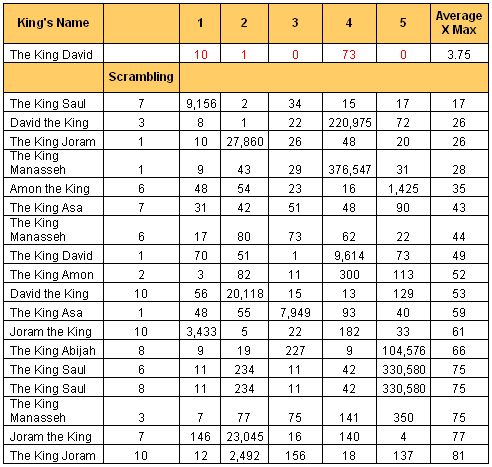
The advantage of excluding the largest difference from the average distance is that it eliminates the distorting effect of including a result that is likely due to chance. When this is done, the average for The King David (3.75) is much less than the average for any of the other royal titles.
If we excluded 40% of the minimum distances, it would be the same as excluding the two largest minimal distances among the five shown for each royal name. When we do that the table above changes to the table below.
Table 7
Average Minimum Distances (Excluding the Two Largest)
Between the Letters of ELSs of Scramblings of Various Royal
Titles and Literal Appearances of David in the Tanakh
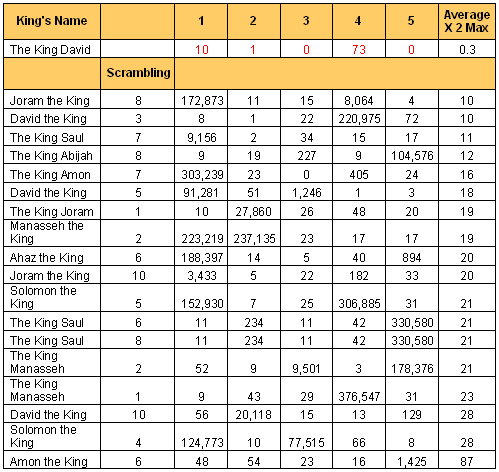
When the two largest minimum distances are excluded from the average distance, the average for The King David (0.3) is again much less than the average for any of the other royal titles.
The next table displays the minimum distances for each of David's four different royal titles. These distances are displayed according to the skip size of the ELS, from the smallest to the largest.
Table 8
Minimum Distances of ELSs of David's Different Royal Titles
Shown by Increasing Rank of Skip Size
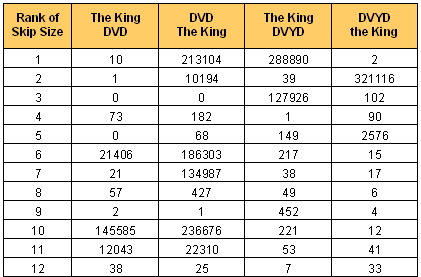
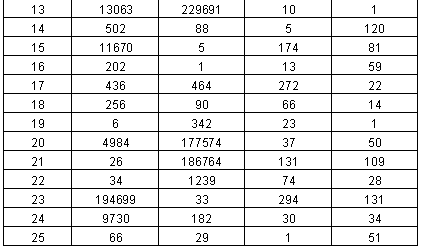
In Table 9, the minimum distances in Table 8 have been rearranged separately for each royal title, with the smallest minimum distances shown first. For comparison, the comparable results are shown for the two royal titles that had the smallest average minimum distances among all of the royal titles of the kings in the House of David. The distances highlighted in yellow below are clearly unusual in comparison to those for other royal titles.
Table 9
Minimum Distances of ELSs of David's Different Royal Titles
Shown by Increasing Rank of Minimum Distance
from Literal Appearance of David in the Tanakh
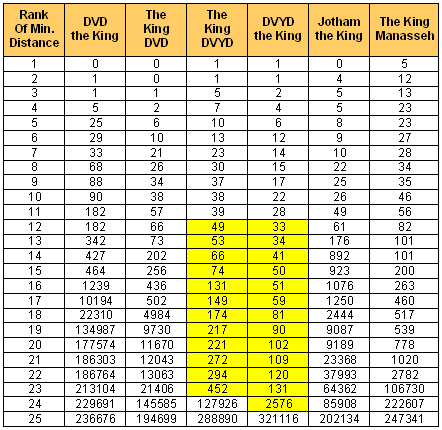
Table 10 displays four different types of average minimum distances for the various royal titles. In the right column are shown the odds of chance occurrence of the average distance (excluding the two largest).
Table 10
Average Minimum Distance of 25 ELSs
with Shortest Skips to Literal David in Text
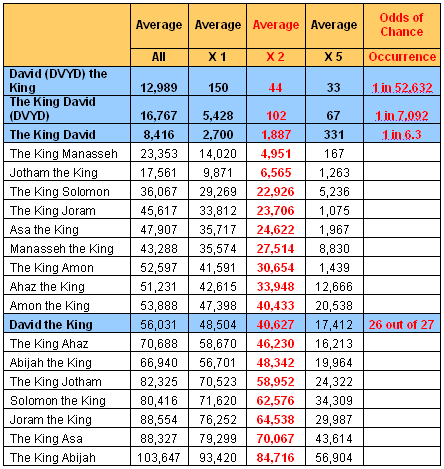
There is no question that it is quite unusual that three of the four royal titles of King David exhibit the shortest average distances to literal mentions of David in the Tanakh. The only issue is how unusual are these results.
Derivation of the Odds of Chance Occurrence
How improbable are the combined results for the two variations of the royal titles of David, spelled with four Hebrew letters? The results of each title are independent of those for the other titles. So we can take the product of the indicated probabilities shown in Table 10:
(1 in 52,632) x (1 in 7,092) = 1 in 373,266,144.
Brief Technical Addendum
How did we come up with the odds of chance occurrence shown in Table 10? In Table 3, we showed 10 different scramblings of the letters of the royal title, The King David. We worked with 80 different scramblings and recorded the minimum distances from literal appearances of David in the Tanakh for the ELSs with the shortest skips. We then recorded all these minimum distances and took random samples of 25 of these distances, and then calculated the resulting averages displayed in Table 10 (i.e., average all, average excluding the largest, average excluding the two largest and average excluding the five largest). We then ran one million trials of these averages, and we noted how many of them were as small or smaller than the observed averages for the different royal titles of King David.
For DVYD the King, the average distance excluding the two largest minimum distances for the 25 ELSs with the shortest skips in the Tanakh was 44. For only 19 out of one million trials was this average less than or equal to 44. This gives us odds of one in 52,632 (19 out of one million divided by 19).
For The King DVYD, the average (X 2) distance was 102. For only 141 out of one million trials was this average less than or equal to 102. That gives us odds of one out of 7,092.
For The King DVD, the average (X 2) distance was 1,887. For 159,459 out of one million trials this average was less than or equal to 1,887. That gives us odds of one out of 6.3.
All of these findings were made using Keys to the Bible software. Because of letter differences in the Hebrew texts used, comparable findings using other software would be different.
Continue to Hebrew Alphabet: Lesson Four
|
|


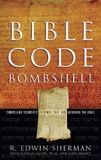 
Bombshell examines two massive, recently discovered clusters of codes in the Hebrew Old Testament. To read more about Bombshell, click here, or click below to order from Amazon today!
 
|







